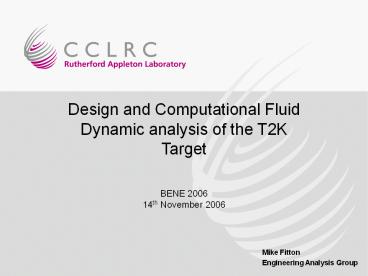RAL Template - PowerPoint PPT Presentation
1 / 23
Title:
RAL Template
Description:
Target rod to be completely encased in titanium to prevent oxidation of ... Matt Rooney's initial calculations suggest this window is ok for pressure and shock. ... – PowerPoint PPT presentation
Number of Views:28
Avg rating:3.0/5.0
Title: RAL Template
1
Design and Computational Fluid Dynamic analysis
of the T2K Target BENE 2006 14th November 2006
2
Contents
- Design Concept
- Design Aims
- RAL Target geometry
- Analysis Outline
- Simulation results
- Summary
- Future Work
3
KEK Concept Design
- Co-axial 2 layer cooling pipe Graphite /
Ti-6Al-4V, Helium cooling
4
KEK Proposed Target Design
Outlet
Inlet
Proton Beam
X Pressure drop too high
X Target would oxidise in low quality helium
5
Aims of RAL Design
- Target rod to be completely encased in titanium
to prevent oxidation of the graphite - Helium should cool both upstream and downstream
titanium window before the target due to material
limits - Pressure drop in the system should be kept to a
minimum due to high flow rate required (ideally
less than 0.7bar) - Target to be uniformly cooled (but kept above
400C to reduce radiation damage) - It should be possible to remotely change the
target in the first horn
6
RAL Target in the 1st Horn
7
Current RAL Target Geometry
8
Target Geometry
Upstream window
Target radius 13mm
Gap optimised to give uniform flow
Inlet outlet manifolds
9
Flow Path
Outlet Manifold
Flow turns 180 at downstream window
Inlet Manifold
Matt Rooneys initial calculations suggest this
window is ok for pressure and shock.
10
Cross Section of Downstream end
Graphite IG-43
He inlet
He outlet
Target Rod
Titanium Ti-6Al-4V
11
Animation of flow
12
Materials
Currently not included in analysis
13
Radiation Damage of Graphite
- For a radiation damaged target a thermal
conductivity of 20 W/m.K is used (approx 4
times lower than new graphite at 1000K)
14
Analysis Outline
- Boundary conditions (Helium Ideal Gas) Fluid
Domain - Inlet Mass flow rate 32g/s (and 25g/s)
- Inlet temperature 300K
- Outlet Pressure 0.9 bar (gauge)
- Heat deposited (30 GeV, 750 kW) Solid Domain
- On target as a function in r and z
- On upstream and downstream window as radial
function - On Inner graphite tube as a function of z
- On Outer tube as a total source
- Model Convergence (Residuals)
- 6x10-6 (RMS)
- 6x10-4 (MAX) Some local mesh refinement needed
15
Velocity Streamlines
Current design
Previous design iteration
Optimised for uniform flow
16
Velocity profile at downstream window
Optimisation for pressure drop and window cooling
Current RAL Design
Original Concept
- Pressure drop unacceptable
- No downstream window
30 GeV, 0.4735Hz, 750 kW Radiation damaged
graphite
17
Window Temperatures
Upstream Window
Downstream Window
Max Steady-State Temperature 92C
Max Steady-State Temperature 95C
Mass flow rate 32 g/s
18
Pressure Distribution
Mass flow rate 25 g/s Total pressure drop
0.792 bar
Previous design DP 0.65 bar (Increase due to
reduction in cross sectional area)
Increase gap size?
30 GeV, 0.4735Hz, 750 kW Radiation damaged
graphite (20 W/m.K)
19
Steady state target temperature
Maximum temperature 1009K 736C
Mass flow rate 32 g/s
30 GeV, 0.4735Hz, 750 kW Radiation damaged
graphite (20 W/m.K)
20
Surface Temperature distribution
30 GeV, 0.4735Hz, 750 kW Radiation damaged
graphite
Contours limited to 250C
21
Results Summary (25 g/s and 32 g/s)
NOTE Steady State Temperatures
Mass Flow Rate (g/s) Pressure drop (bar) Helium Temperature Rise (C) Target Core (C) Upstream Window (C) Downstream Window (C)
25 0.55 167.5 866 114 109
32 0.79 130.4 735 99 92
Temperature rise in helium 21.7kW
22
Future Work
- Include outer titanium upstream structure in
analysis - Refine mesh to obtain better convergence
- Analyse thermal stresses and deflections in the
target structure - Compare CFD results with prototype target.
23
Questions ?

